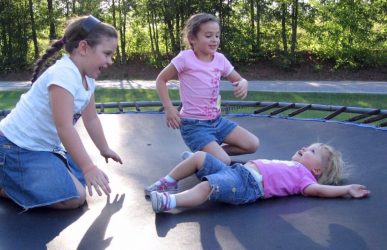Trampolining and Autistic Spectrum Disorder
Children and adolescents on the Autistic Spectrum seem to get a huge amount out of a trampoline. I have come across several kids who regularly spend long periods of time happily bouncing. This can only be a good thing so long as reasonable care has been taken to make the trampoline safe.
Autistic Spectrum Disorder can be associated with a propensity towards depression. The fun of bouncing gives a general feeling of well-being, raises mood and is a great way to relieve extra stress and energy. Bouncing is usually achievable for kids on the spectrum so can be a good opportunity for task and goal setting.
The time spent bouncing also provides a welcome break for the carer. Aside from the fun of bouncing on a trampoline, there are huge physical benefits. It is a great cardio vascular workout, developing fitness, balance and coordination. These benefits can be received by children of all ages and abilities (even adults too) but especially good for those on the autistic spectrum, as it can sometimes be hard to find a safe activity involving exercise that they will enjoy.
If you care for a child on the spectrum I would urge you to look into getting a trampoline for your garden. Trampoline safety is bound to be a major concern and can be more so for parents with autistic children as they do not necessarily have the same coordination and balance as a fully able child. Naturally safety is a concern for any parent so these guidelines can be useful to those with children who do not have autism as well.
Trampoline safety comes first!
Here are a few trampoline safety tips that will be useful for people with autism but equally as useful for those without:
- Fit a safety surround, preferably the type where the net is held away from the steel legs on elastic tags and inside the circular pads that cover the springs. This is by far the safest design.
- A bigger trampoline will give the child more space to fall over or recover their balance safely than a small one so get the biggest you can.
- Site the trampoline on a flat and level surface.
- Use a trampoline ladder designed for your size of trampoline for safe mounting and dismounting.
- Make it a rule that only 1 person at a time is allowed on the trampoline – good luck with that one! I know it would be hard to stop children from playing together on a trampoline, but definitely a rule to take seriously if your child is at the higher end of the autistic spectrum.
- Supervise at all times – this may sound obvious but you would be surprised how many people assume having a trampoline with enclosure suddenly makes their child indestructible. Make sure you keep a good eye on your child or children whilst they are on the trampoline, and make sure they can’t access it when you are not looking!
Follow these guidelines as closely as you can and you will be able to relax knowing your child is enjoying safe and fun exercise.
Written by: Gavin Stride
Gavin has worked for Big Game Hunters for many years, selling and advising on outdoor play and outdoor play equipment.



